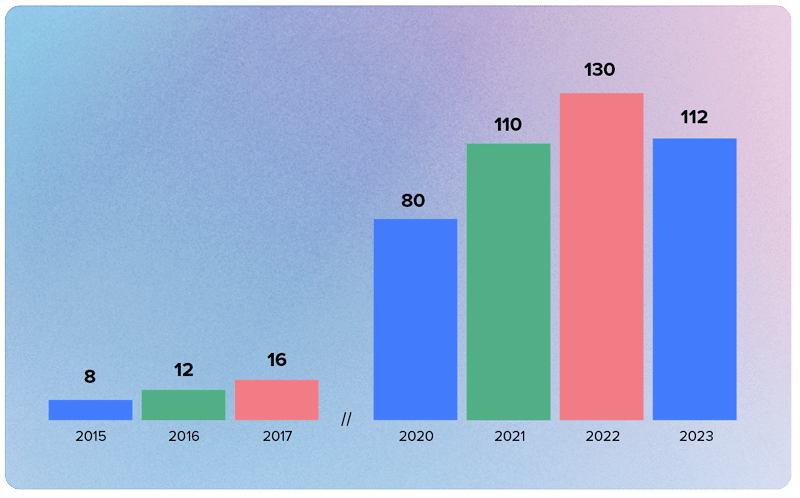State of SaaSOps 2024: Consolidation is the new IT mantra
June 27, 2024
5 minute read

IT departments are in a pressure cooker. They’re tasked with doing more with less, constantly innovating, and somehow keeping the lights on – all while facing ever-shrinking budgets.
The loudest directive? Cut costs.
This relentless pressure to tighten belts coincides with a fascinating trend in the SaaS landscape. BetterCloud’s 2024 State of SaaSOps report found that for the first time ever, SaaS growth stalled – for the first time ever.

What does this mean for the future of IT? It’s a sign of a maturing IT landscape, not a stagnant one. Businesses are realizing the value of software that already exists in their techstack that offers multiple functionalities, eliminating the need for redundant tools with overlapping features.
In this mini-release, we want to delve into this eye opening finding from this year’s report (coming July 9!). We’ll explore the challenges of a massive techstack and how consolidation can really benefit your organization without sacrificing functionality.
How we got here
The tech world witnessed an explosion of SaaS applications, with companies readily adopting new solutions for every niche need. This convenience, however, came at the cost of “SaaS sprawl,” where businesses ended up managing a bloated stack with redundancies and security vulnerabilities.
Fast forward to today, and we’re in a climate of heightened scrutiny, where every dollar spent is carefully measured against the value delivered. This has led companies to consolidate their tech stacks, prioritizing core functionality and eliminating unnecessary applications.
Why consolidation is the answer
With cost-cutting a top priority for the CFO, IT faces a delicate balancing act: ensuring essential features for the team’s work while upholding strong security measures. As financial accountability takes center stage in IT, consolidation emerges as a critical strategy.
Cost optimization
Consolidation can significantly reduce IT spending in two key ways:
- Eliminating redundant subscriptions: Many organizations have multiple subscriptions for similar software or services due to departmental purchases or legacy systems. Consolidation helps identify and eliminate these overlaps, freeing up valuable funds.
- Negotiation power: By centralizing purchasing decisions, you gain leverage when negotiating with vendors. With a larger volume of business, you can secure better pricing and potentially even additional features or support.
Streamlined operations
Managing a complex IT environment with a plethora of SaaS applications can be a time-consuming nightmare. Consolidation simplifies operations by:
- Standardization: Having one set of tools for specific tasks like CRM or project management eliminates the need for training and support on multiple platforms. This translates to a more efficient workforce.
- Reduced administrative burden: Consolidation minimizes the administrative tasks associated with managing multiple licenses, user accounts, and configurations. This frees up IT staff to focus on more strategic initiatives.
Enhanced security
A sprawling IT landscape with numerous access points presents a larger target for cyberattacks (case and point). Consolidation strengthens your security posture by:
- Reduced attack surface: Fewer systems and login credentials mean fewer potential entry points for attackers. This makes it harder for unauthorized access and data breaches.
- Improved management: Consolidation simplifies security management by allowing you to focus resources on a smaller set of systems. This facilitates the implementation and monitoring of security policies.
“
53% of an organization’s licenses are underutilized, going without a login for one year”
– Source
So, how does IT consolidate SaaS effectively?
Taming the ever-growing jungle of SaaS applications requires a strategic two-pronged approach: streamlining the application landscape and implementing strategic management practices.
Let’s delve into each of these methods:
1. Streamlining the application landscape
- Regular SaaS audits: Just like a cluttered closet needs a clean-out, your SaaS stack needs regular audits. These audits help identify underutilized tools or overlapping functionalities across different departments. Think of it as a spring cleaning for your software subscriptions!
- User needs and usage evaluation: Don’t be fooled by fancy marketing materials. Evaluate user needs and actual usage patterns to determine if a tool is truly delivering value. Are there features going to waste? Is there a simpler solution that meets everyone’s requirements?
2. Strategic management practices
- Planning and forecasting for savvy spending: Gone are the days of impulsive SaaS purchases. By implementing proper software spend planning and forecasting, you can ensure your budget aligns with your organization’s goals.
- Implement a SaaS Management Platform
- Visibility: Gain a clear view of all your SaaS subscriptions and usage data
- Control: Empower your IT team to manage licenses, automate tasks, and enforce policies
- Effective cost cutting: With better visibility, you can identify opportunities for spend optimization. Data is key here – a SaaS Management Platform with spend management can provide insights and benchmarks to help you make informed decisions
Managing SaaS and their spend won’t be possible without automation
Gone are the days when IT teams could manually manage a growing number of SaaS applications and their associated costs. Lean IT teams simply don’t have the bandwidth to tackle everything themselves. This is where automation becomes a life saver, empowering IT to achieve more with less.

The 2024 State of SaaSOps report validates this. IT professionals are experiencing significant advantages by automating their SaaS management processes.
Here’s a closer look at why automation is crucial for IT to excel:
- Continuous SaaS spend optimization: Automation keeps a constant eye on your SaaS subscriptions, identifying underutilized licenses or duplicate subscriptions. This allows you to optimize spending and reallocate resources where they bring the most value.
- Never miss a renewal again: Say goodbye to missed renewal dates and potential service disruptions. Automation takes care of renewals, ensuring continuous access to critical SaaS applications.
- Boost operational efficiency: Repetitive tasks like user provisioning, deprovisioning, and permission management become automated, freeing up valuable IT time for more strategic initiatives.
- Enhanced compliance and data security: Automation enforces security policies and access controls consistently across your SaaS landscape, minimizing the risk of data breaches and ensuring compliance with regulations.
- Stronger IT-Business collaboration: By streamlining SaaS management, IT fosters a more collaborative relationship with the business. Freed from tedious tasks, IT can focus on strategic discussions with stakeholders, aligning SaaS use with business goals, and improving employee sentiment towards IT services.
The future of SaaS management is here: Take control and cut costs
IT departments are juggling an impossible task: doing more with less. But there’s a silver lining in the stagnant SaaS growth – a chance to optimize your tech stack and free up valuable resources.
Consolidation isn’t just about cutting costs (although that’s a major benefit!). It simplifies operations, enhances security, and empowers your team to focus on what matters.
Ready to see how BetterCloud can help you achieve SaaS management nirvana?
Book a free demo today and discover how our platform streamlines your tech stack, automates spend optimization, and empowers your IT team to thrive in this new era.






